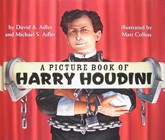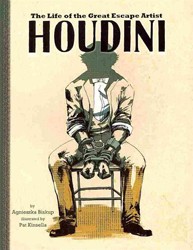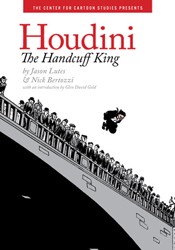By
– September 1, 2011
When Harry Houdini died on October 31, 1926, he was a world renowned magician/escape artist whose performances drew thousands of spectators. There is a plethora of material about this legendary figure along with his own writings. Houdini: Art and Magic has been published in conjunction with the exhibition at the Jewish Museum in New York, which runs through March, 2011 and will then travel to three other venues through May 2012. The book contains reproductions of Houdini’s apparatus, including the water torture cell, the famous milk can (filled with water in which Houdini waslocked, then submerged and from which he escaped in under three minutes) straightjackets, and manacles. Also reproduced are archival newspaper clippings and pages from his own notebooks. Rapaport’s fascinating essay on the poster art produced by Houdini and his agents advertising performances, themselves playing a significant role in bringing a small time magician to center stage. Photographs from the Library of Congress as well as from the many private collections of Houdiniana illustrate the biographical essays which contextualize Houdini in American social history and challenge some conventional “facts” about Houdini.
Born Erich Weiss, the son of immigrants from Hungary, he fashioned his name based on the famous French magician Sean Eugene Robert-Houdin. Houdini was multifaceted, which the essays amply demonstrate: in addition to creating his own performances with his wife as his assistant, he was an avid book collector and interested in furthering the professionalism of the theater. He exposed Spiritualists, he wrote a book on Robert-Houdin, he was a friend of Sir Arthur Conan Doyle, Will Rogers, and of the poet Carl Sandburg. Best of all he kept a diary, pages of which greet the reader upon opening the book. An interview with E.L. Doctorow, who incorporates Houdini in his novel Ragtime; an interview with the magician Teller (of Penn and Teller); an interview with a contemporary artist who along with other artists have been inspired by Houdini to create works of art (reproduced in the book) make this volume a first-rate contribution to the Houdini canon. Extensive notes and index.
Born Erich Weiss, the son of immigrants from Hungary, he fashioned his name based on the famous French magician Sean Eugene Robert-Houdin. Houdini was multifaceted, which the essays amply demonstrate: in addition to creating his own performances with his wife as his assistant, he was an avid book collector and interested in furthering the professionalism of the theater. He exposed Spiritualists, he wrote a book on Robert-Houdin, he was a friend of Sir Arthur Conan Doyle, Will Rogers, and of the poet Carl Sandburg. Best of all he kept a diary, pages of which greet the reader upon opening the book. An interview with E.L. Doctorow, who incorporates Houdini in his novel Ragtime; an interview with the magician Teller (of Penn and Teller); an interview with a contemporary artist who along with other artists have been inspired by Houdini to create works of art (reproduced in the book) make this volume a first-rate contribution to the Houdini canon. Extensive notes and index.
Esther Nussbaum, the head librarian of Ramaz Upper School for 30 years, is now education and special projects coordinator of the Halachic Organ Donor Society. A past editor of Jewish Book World, she continues to review for this and other publications.




